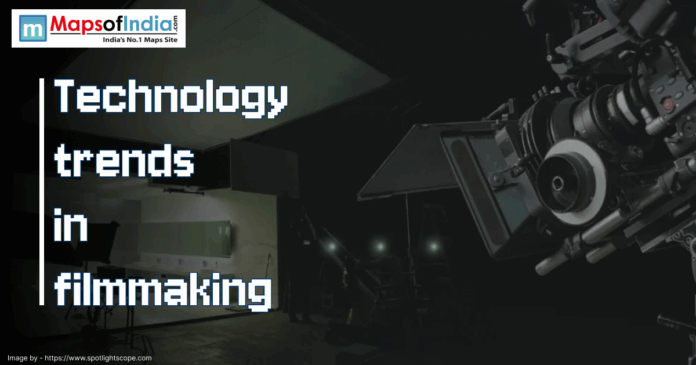Filmmaking has always demanded changes and thrives on innovation. With the changing technology, the form of storytelling is also reshaped. Filmmaking, the art of visual storytelling, has changed from silent films to immersive virtual screens, and the tools of filmmaking are evolving fast. In recent years, advancements in technology, such as the use of AI and drones, have revolutionized cinema. The newly developed technologies enhance creativity and cut costs. A recent Deloitte report predicts a $10 billion tech impact on film. Directors and studios embrace these changes and are changing with them. Audiences demand richer experiences.
AI-Driven Scriptwriting and Pre-Production
The use of Artificial intelligence technology streamlines the process of pre-production. Online, many AI tools help to analyze scripts and give appropriate suggestions. These AI tools predict box office success with 84% accuracy. There are also algorithms present that suggest which plot will work with the trend and which will not. These tools identify audience appeal. AI also generates storyboards from text, making the scripting process simpler. According to the Hollywood Reporter article, these AI tools have made the planning process 30% faster. Tools like Plotagon create animated pre-visualisations. The use of this free software cut costs by 20%. AI also scouts required locations virtually. It matches scripts to real-world sites. A recent McKinsey report says 60% of studios use AI in the pre-production stage. This small task saves time and money. Creativity remains human-led. AI enhances efficiency in the early stages.
Virtual Production with LED Walls
The use of virtual production on the sets has transformed sets. Now on the sets, LED walls replace green screens. This screen displays real-time digital backgrounds. The Disney series The Mandalorian popularised this technology. ILM’s StageCraft uses an Unreal Engine. It renders 3D environments instantly. While filming, actors see settings in which they need to act and not just blank screens. A Film Technology journal notes 40% better immersion. Cameras track movements to give parallax effects. This syncs visuals with shots. With the use of this technology costs of shooting drop by 25% versus physical sets. Smaller studios use portable LED walls. The use of real-time tweaks saves post-production time. These Virtual production techniques boost realism on set. It’s now a Hollywood staple.
Drone Cinematography: Aerial Perspectives
The use of drones has changed how aerial shots are done. With the help of a drone, we can capture angles that once required helicopters to shoot. Nowadays, most filmmakers for aerial shots use drones. DJI’s Inspire 3 carries 8K cameras. It films at 120 fps. A CineD article praises this drone for its stability. Drones cost $5000 to $20000, while for the same scene crane can cost up to $50000. They navigate tight spaces like forests. Top Gun: Maverick used drones for jet sequences. According to the Variety report, the use of drones helps studios to save 15% of their budget. If the drone has an AI-powered system, then it can follow subjects autonomously. Safety protocols reduce crash risks. Drones offer creative freedom to filmmakers. They make epic shots accessible.
Motion Capture and Digital Characters
With the use of motion capture technology, filmmakers can create lifelike digital characters. In this technology, they track actors’ movements via sensors. An IEEE Spectrum report says this sensor captures movement with 95% accuracy. Films like Avatar rely on this technology. Weta Digital’s suits capture facial expressions. A Nature Technology article notes 50% faster rendering. Real-time mo-cap integrates with virtual sets. Actors interact with digital worlds live. The Hollywood Reporter says costs dropped 30% with the use of this technology. Smaller studios can use affordable systems like Xsens. With this technology, we can replace stunt performance with digital doubles. This also reduces the risk of injury by 20%. Motion capture technology blends human and digital art. It’s key for sci-fi and fantasy.
AI-Powered Post-Production and Editing
Sometimes a film is made in the post-production process. Post-production is mostly done using various software. Nowadays, AI is also integrated into these tools. Software like Adobe Premiere’s Auto Reframe adjusts shots. They optimize for 16:9 or vertical formats. According to the TechCrunch report, the involvement of this AI in editing tools saves 40% editing time. AI colour grading enhances visuals. Runway ML removes objects from frames. Sound design has also changed. With the help of AI, we can isolate dialogue from noise. A Sound on Sound report says it cuts audio cleanup by 50%. Visual effects rendering is faster. NVIDIA’s GPUs process 4K frames in seconds. AI reduces manual labour. Editors focus on creative choices. Post-production is now smarter and quicker.
Immersive Audio: Dolby Atmos and Beyond
The use of proper sound design elevates the process of storytelling. Tools like Dolby Atmos create 3D audio. According to the Dolby report, more than 80% of blockbuster movies use this technology. Speakers place sound above and around viewers. The movie Dune used 128 audio channels. Using Auro-3D adds height layers. This technology is cheaper for smaller theatres. According to the Variety report, there are around 10000 Atmos theatres globally. AI mixes tracks for spatial effects. Binaural audio enhances VR films. A Journal of Audio Engineering says it boosts immersion by 25%. Soundscapes feel real. Immersive audio captivates audiences.
Virtual Reality and Interactive Storytelling
The development of virtual reality tools is reshaping cinema. The films made with VR give 360-degree views. Audiences can choose which perspective they want to watch. A Statista report says the film with VR films is generating $1.2 billion in revenue. Oculus Rift and HTC Vive lead headsets. Carne y Arena by Iñárritu immerses viewers in migration stories. Interactive films let viewers pick plot paths. Netflix’s Black Mirror: Bandersnatch set the trend. A Forbes report says 20% of studios experiment with VR. Production costs range from $50000 to $500000. VR requires new storytelling skills. It blends gaming and film. This trend pushes creative boundaries.
Conclusion
The use of new Tech trends redefines filmmaking. The use of AI cuts in the pre-production process cuts the time by 30%. Virtual production saves 25% time on sets. Drones reduce aerial costs significantly. And give filmmakers a chance to experiment. Motion capture has generated a new wave in the film industry. Believable characters. AI editing streamlines post-production. Immersive audio boosts. VR offers new narrative forms. Studios need to keep up with audience demand, adapt to new technologies as necessary. These tools made it easy for everyone to practice filmmaking. Indie filmmakers can make Hollywood-standard movies. Ethical concerns like AI bias are still there. Tech drives creativity and accessibility.




